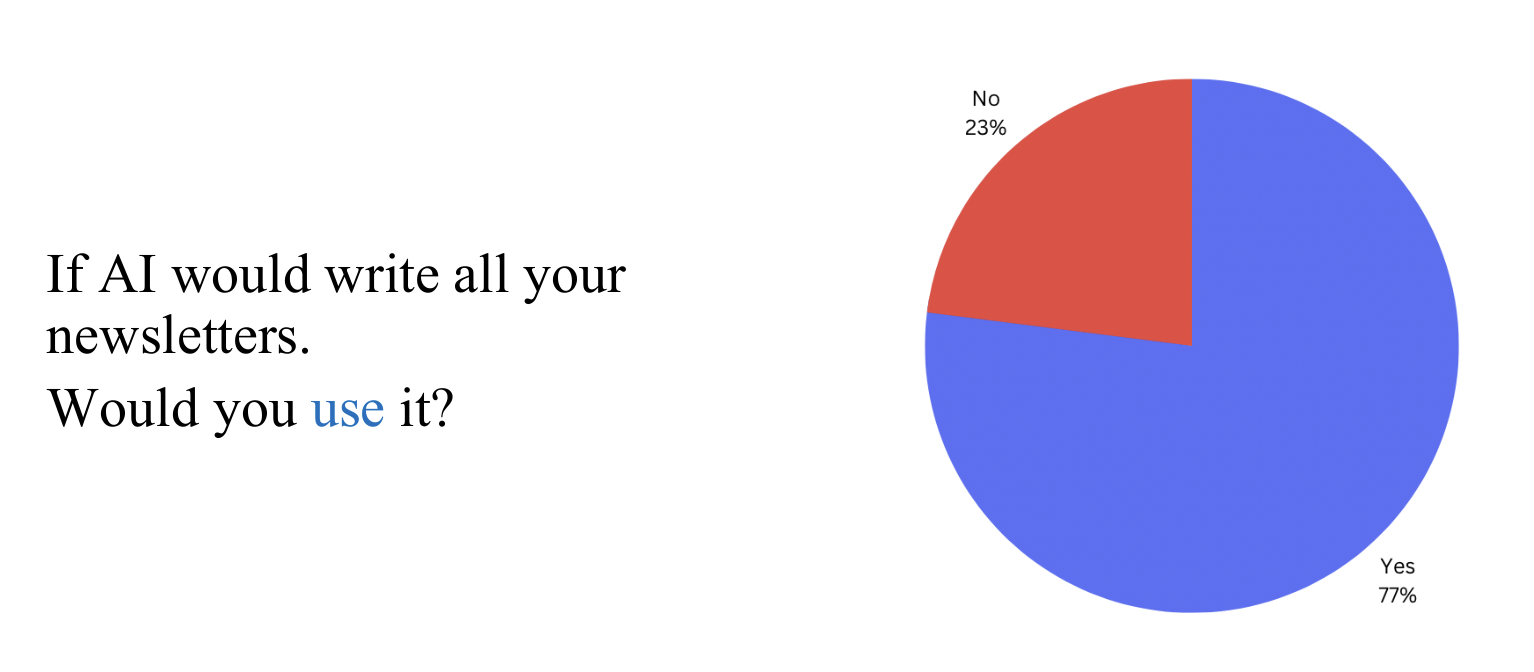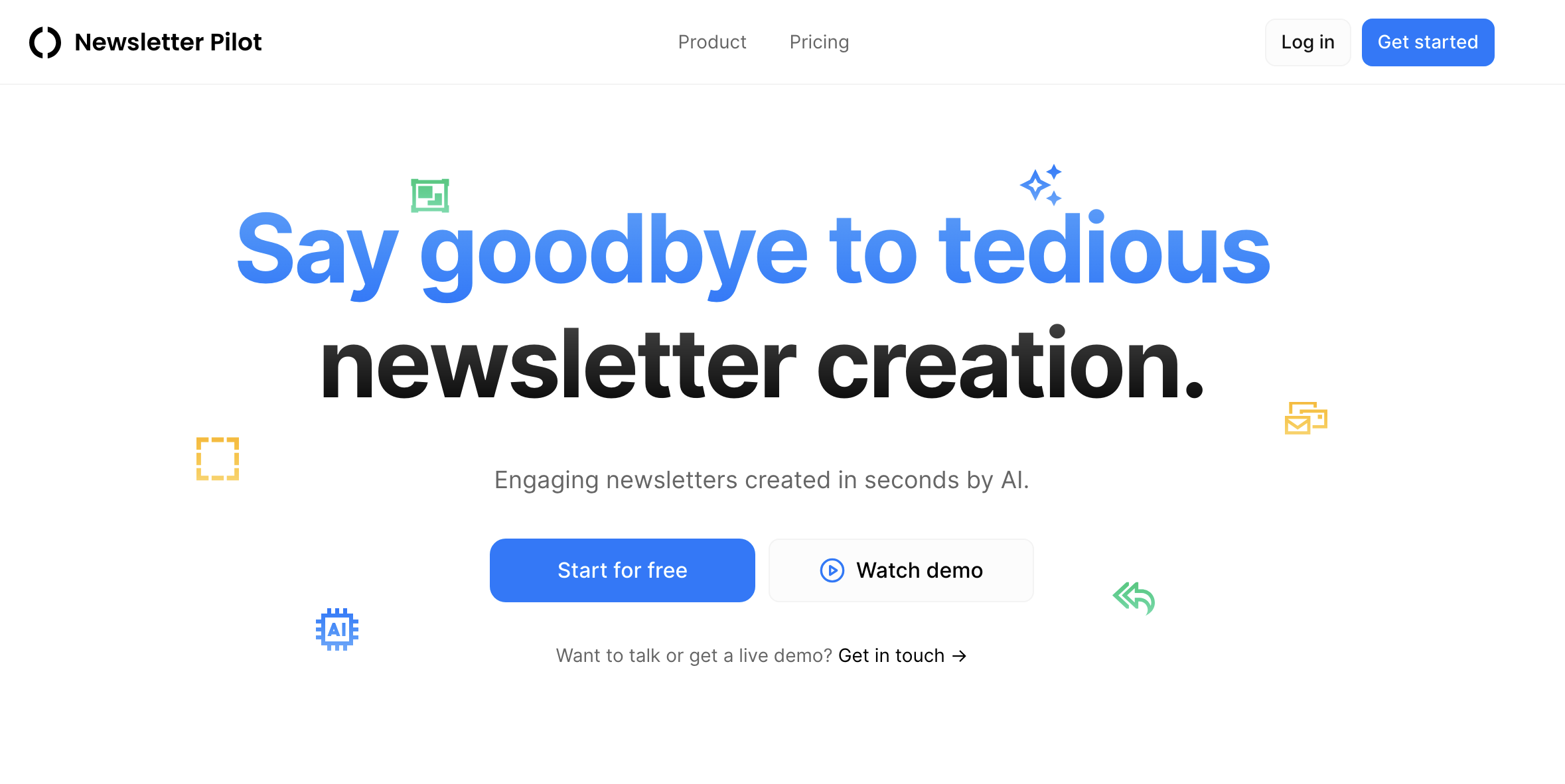In this blog, I will take you through my 4-month-long startup's journey of failure, providing honest insights into the lessons learned along the way. Join me as I walk you through the highs and lows of confirmation bias.
Food for thought; if my startup did not make any revenue, can we call it a startup?
Anyway, my story begins with an idea, born on a casual night out with friends.
Idea Generation: The one night out
Good business ideas can come at any time and any place. Morning shower, 8-hour drive cuddling with your spouse. We all have great ideas but as we know... it is not about an idea but all about execution.
It was March 2023, the start of the AI frenzy, and I was hanging out with friends at a bar just a week after my sabbatical. We were chatting about AI, and even though I had no AI business ideas, a bit of alcohol-fueled creativity kicked in. So, I blurted out, "Let's fully automate newsletter creation!" It occurred to me that newsletters are often just summaries of blog articles, and creating them seemed like a real chore.
There is also a structured way to generate good business ideas. Read more about it here.
1. Problem Validation: Taking the Plunge
The next day, with a bit of a hangover, I wondered if my boozy idea might actually work. To check, I made a survey and shared it with marketers on LinkedIn and other relevant places. I got about 50 responses. To be sure my findings weren't based on too small a group, I shelled out some cash for Pollfish to get 300 more responses. The results were clear: 70% of newsletters mostly promoted blog content, backing up my original concept.

I also had around 30 interviews. They confirmed:
- Newsletters were low on people's priority lists.
- They create newsletters randomly, without a certain frequency
- It took up to 3 hours to create 1 newsletter
- The results weren't that impressive.
- Marketers would pay for an AI written newsletter

2. Validate demand for my solution
To solidify my idea, I created a waiting list and got over 200 interested folks, proving there was a demand.
I created a no-code landing page clearly stating the value proposition of my idea.
Before that, I bought the domain newsletterpilot.com (AI generated this name)
Shared it in relevant groups and across social.
3. Build an MVP
To make this idea a reality, I talked to several developers, from beginners to pros. We wanted to create a basic version without spending too much time and money.
I received some cost estimations and decided to work with an indie hacker who eventually became my co-founder at SaaS Garden Studio. Thanks to Ivan Homola for offering the most competitive price :D and an agile approach.
We settled on €3,000 for an MVP.
During the development process, we redefined the MVP and simplified it further.
Initially, our plan was to scrape the entire site and all its blogs, selecting content based on specific criteria (such as the last 4 blogs and the most popular ones) to create the newsletter according to the chosen frequency (e.g., once a week).
This web crawling feature is technically complex, and based on feedback from my interviews, people expressed that it would be sufficient for them to simply paste certain articles, allowing Newsletter Pilot to generate the newsletter for them.
While we had intentions to integrate with mailing tools like Mailchimp, we decided to first gauge people's satisfaction with the newsletter results.
So, we opted for a more manual approach for the time being.
4. Beautiful design is overkill at this stage
I recognized the importance of making the product as user-friendly and self-explanatory as possible.
I reached out to one of the best product designers I know, and together, we created wireframes.
He even designed a beautiful website.
He used Framer, a fantastic tool for advanced designs, but it requires a basic understanding of code and can be a bit pricey in the early stages.
60€/month is quite a lot for pre-revenue bootstrap.
The product designer crafted a beautiful product design. However, a clash emerged with Ivan, the software developer.
Developing a pixel-perfect front end requires a significant amount of time.
To be time and cost-effective, you need to leverage several open libraries, webhooks, and other tools.
So, we found a middle ground. The most crucial aspect was ensuring that users could reach their "AHA moment" as quickly as possible.
Ivan and the product designer worked together to strike a balance.
Next time I would use product designers once you reach at least 10.000€ MRR
Use product designers as an advisor to help you craft a wireframe, not to deliver the final design.

5. The launch
We implemented a multi-pronged approach to launch our product, which included AI tool listings, Product Hunt campaign, personal LinkedIn outreach, free tools, social media and search ads.
Avoid making the mistake I've seen other pre-revenue, low-tech startups make.
Activities like SEO, partnerships, community building, and others that yield long-term results are excellent once you've found product-market fit.
However, in the early stages, you need to onboard your first set of early adopters as quickly as possible. Utilize your network, engage in direct sales, run paid ads, and more to achieve this goal.
6. Clear Problem, Unclear Persona
Despite knowing that newsletters were a pain point for many, I struggled to identify a single persona with a pressing need for our solution.
Our potential users included content creators, marketers, small business owners, and corporations, all with different use cases.
They had one thing in common: they didn't like to write newsletters, considering it a low-priority task. Some of them even failed to see the value in newsletters.
The challenge was that each of them approached newsletter creation differently, and we lacked a one-size-fits-all solution.
This diversity made crafting marketing messages and selecting sales channels challenging.
This gave us a hint that the problem we try to solve is not so painful.
You bet ;) We have successfully ignored this hint.
7. Zero Retention and Elusive Feedback
We had over 800 people try Newsletter Pilot, but most of them never came back or returned infrequently. This makes sense when you only create newsletters twice a month.
We were aware of this issue. Our initial idea was to fully automate newsletter creation so that our users would receive a generated newsletter for approval in their inbox once a week.
To establish a user habit, we needed to try different approaches. Email onboarding and reminders didn't yield the desired results, and remarketing PPCs also proved ineffective.
8. Finding the Frequent Problem
We needed to understand what users thought of Newsletter Pilot, what they were missing, and how they felt about the output.
However, people weren't engaging with us. They didn't respond to our emails, even when we tried to incentivize them with offers like getting the tool for 6 months for free—just tell us what you think.
We received only a few responses, and we faced a challenge in getting people back on calls.
After a while, we finally received some great constructive feedback from our super-early adopters.
What feature do you miss so you would instantly pay for?
There wasn't one clear missing feature. Everyone wanted something else.
We had a hypothesis that if people wouldn't provide feedback, the problem might not be painful enough for them to bother talking to us.
Conclusion: If people don't communicate with you, it's an indication that the problem might not exist.
9. Returning to Our Initial Proposition
With over 800 trialists but low retention, we had to rethink our approach. Recognizing that our target audience created newsletters infrequently, we concluded that the only way to establish a user habit was to fully automate newsletter creation, as originally intended.
However, a competitive analysis revealed that our proposed solutions were already offered by major players like Mailchimp and Mailer Lite.
10. Threads We Ignored (sw
We were aware that competitors would implement similar solutions to their offering. However, we believe that they will offer it only in premium tiers (+200€/m)
Our competitors were undercutting us, offering similar solutions for a fraction of our price.
This stark reality forced us to reevaluate the viability of Newsletter Pilot.
11. Why We Pulled the Plug
In the end, we decided to shut down Newsletter Pilot for several reasons:
- The problem wasn't as painful for our audience as we had initially thought.
- The problem wasn't frequent enough to create a sustainable user base.
- The market was overcompetitive, making it challenging to find a unique niche.
The Cost of Lessons Learned
Our journey came at a cost, totaling €9,000:
- Software development: €4,000
- PPC testing and demand analysis: €1,500
- Product and website design, including animated videos: €2,000 (consider postponing this expense until after initial traction)
- Listings and directories: €1,000
- Databases and tools (Intercom, Framer, Topol): €300 per month
This is quite a good price considering what we have developed and especially learned.
Next time we can do it 2x fast and at half of the price.
How We Sold the Idea of Failure
In the ever-evolving world of startups, we realized the importance of selling our ideas before investing significant resources.
Our experience with Newsletter Pilot exemplifies our approach to swiftly build and, when necessary, kill SaaS projects without incurring crippling financial losses.
We prioritize problems over ideas and embrace failure as a stepping stone to success.
In SaaS Garden Studio, we view software startups differently, focusing on validation and user engagement before committing to a fully developed product. Newsletter Pilot serves as a testament to our agile approach and willingness to pivot when needed.
We aim to provide young, talented minds with an opportunity to become serial entrepreneurs. We want to show them an alternative to the VC world because many SaaS ideas are a great fit for bootstrapping and achieving profitability.
Young folks joining SaaS Garden have a 30% chance of succeeding and building a profitable business, compared to a 1% success rate when embarking on a VC-backed journey.
